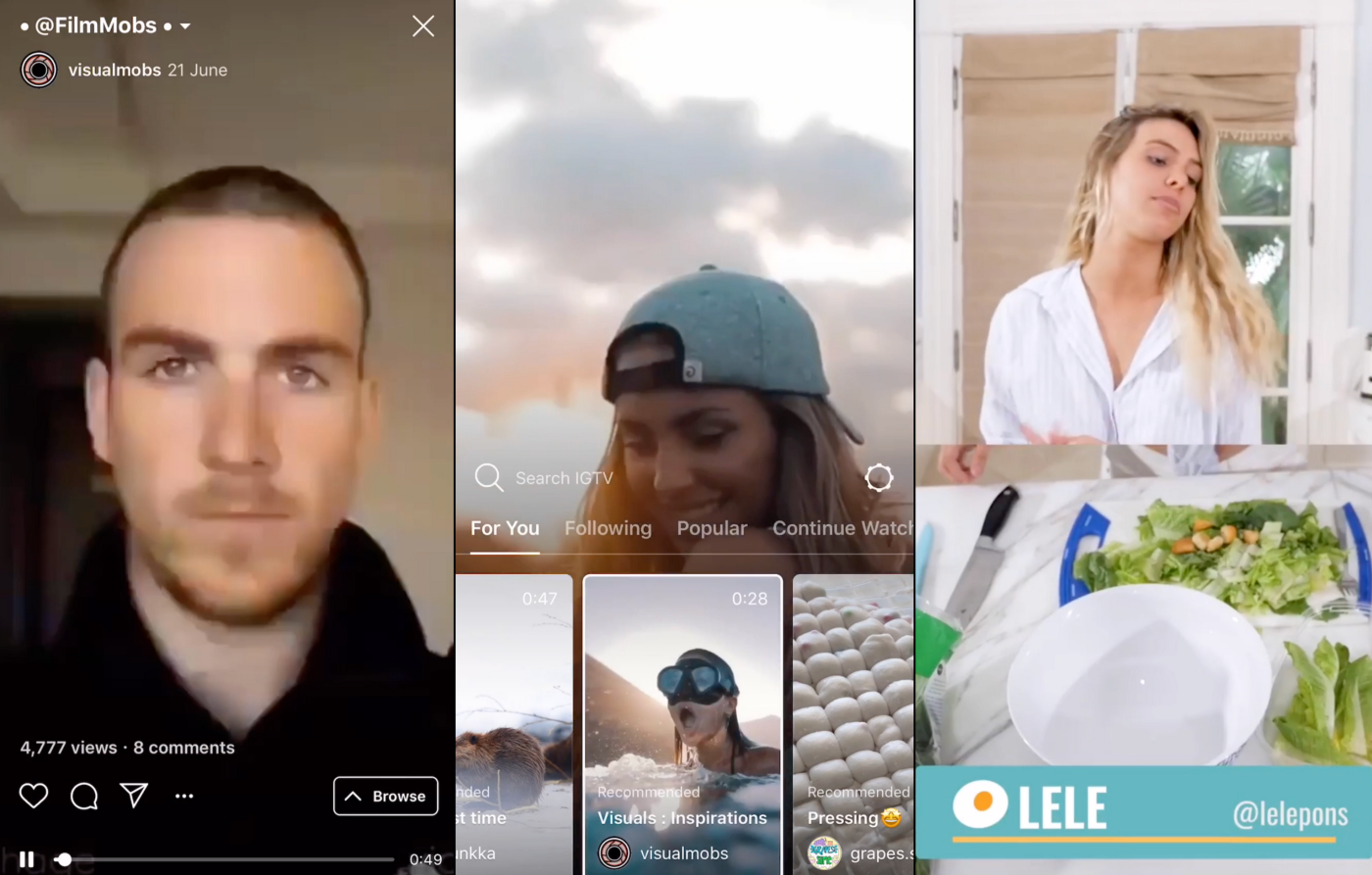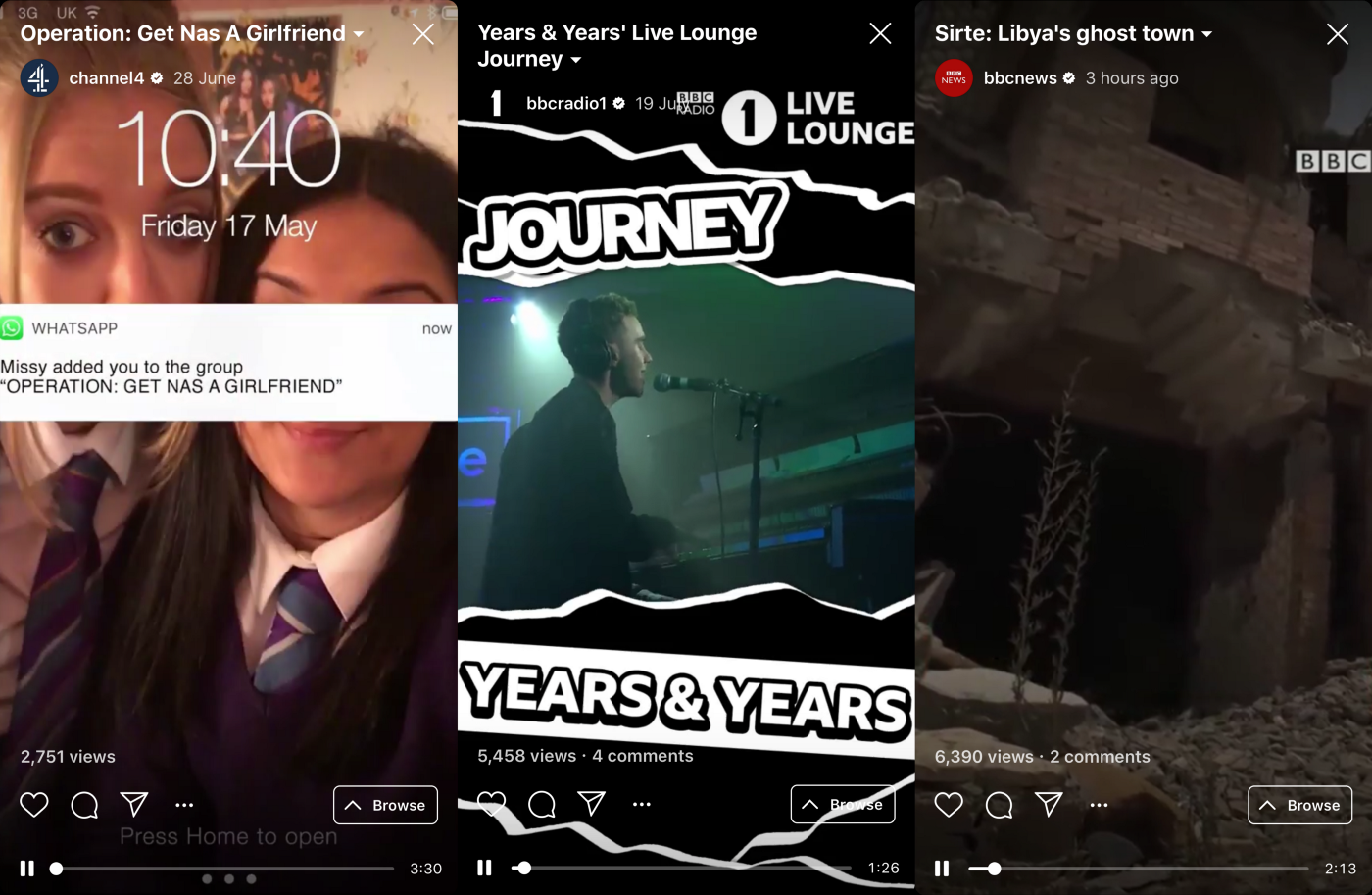What is IGTV?
IGTV is non-expiring long form, vertical video within the Instagram ecosystem. Users will be able to post video content to IGTV up to an hour in length. It appears in a new, discrete area within the app and does not (currently) appear anywhere else on the platform outside of the IGTV portal.
This is significantly different from the already established Instagram Video, the square videos users can post on your timeline but also appears in the discover tab. Instagram Stories and Instagram Live are already both vertical video formats that exist on Instagram. IGTV raises many questions, not only in terms of where it fits in the average person’s media diet but also in where Instagram is heading in its overall content strategy.

IGTV Screenshots from @visualmobs and @lelepons
So, why have they done this?
It has been abundantly apparent that the Facebook/Instagram vision has become focused on centralising the core features of the social internet within their ecosystem. With Instagram being the primary destination for Gen Z’s social media experience, Instagram has been adding features that cater to online social interactions outside of simply photo sharing. This can be seen with direct message, video chat, shopping features and Stories. With Facebook’s own push for video, IGTV should not come as a surprise but as an inevitability. What is a surprise is the bold choice to invest fully in the previously uncharted territory of non-expiring, long form 9:16 portrait video.
Another surprising characteristic of IGTV is the barriers to entry that the architecture provides. Every Instagram user can immediately consume IGTV content natively within the Instagram app. However, unlike Instagram Stories, Live and Video, IGTV content requires another app in to upload to the service. While is this an almost arbitrary step, it is significant in self-selecting the types on content that Instagram hope will be uploaded. The casual Instagram user will not deicide to create IGTV content on a whim the same way they would with Instagram Stories. In this way, IGTV is positioned in a significantly different place to the other video products.
Outside of how it is set up, it is too early to tell exactly what the tone and quality of IGTV content will be. It’s a wild west right now. While creators and brands alike are experimenting with formats for original content, mostly they are trying to learn how to best to repackage standard 16:9 video for the new format. The platform currently consists largely of reposts of Instagram Stories or badly resized YouTube videos. Some creators are archiving interesting Instagram livestream clips. Currently, the platform seems to be a junkyard of reposts. This doesn’t mean it is doomed to fail. Democratised portrait video has never been centralised on a platform and it will take time for consumers and producers to acclimate to the new format. Although early engagement has been reported to be higher than Instagram stories, it’s difficult to conclude anything meaningful as launch day hype will be a significant contributing factor.

IGTV Screenshots from channel4, bbcradio1 and bbcnews
In terms of the hierarchy of online video delivery, IGTV likely fits in between Vine and YouTube. It is similar only to to Snapchat Discover, in its native portrait video ecosystem. With Snapchat being an Instagram Stories competitor, it is possible that this move is intended to offer substitutes to other aspects of the Snapchat user experience in order to increase its market share. As Gen Z ages, becoming older and richer, the battle for their eyeballs is only set to become fiercer.
What does it mean for advertisers?
While there is still no native ad platform on IGTV, it would be unsurprising to see ads implemented in the same way as Instagram Stories — in the same format, in between videos — once the platform matures. This doesn’t mean that IGTV can’t be uniquely valuable for creative advertising; it brings a dynamic and diverse new platform to leverage.
In this way, Snapchat Discover is a good blueprint to follow. IGTV allows advertisers to push high quality content natively to their followers.. On Snapchat, the content placed on Discover is served through deals made between large media conglomerates and Snapchat themselves. It is advertising presented as native content. While users choose to watch what they enjoy, the choices provided are limited to channels like Buzzfeed or Daily Mail rather than anyone and everyone.
IGTV brings this to the masses, making it possible to post vertical, Snapchat Discover-esque content in engaging and dynamic ways. Remember, this is the format that is native to the most used device in the modern era: the smartphone, the portrait-oriented multimedia device in everybody’s pocket.
While this multifaceted experience encourages brands to build native audiences on the platform, however, 9:16 is a format that brands are likely not already producing in. This means they face a decision to make on how much time and money they are willing to invest in the new format. Brands could become highly rewarded for early adoption, however the barriers to entry could leave the platform barren of content as well as users.
